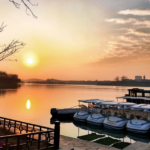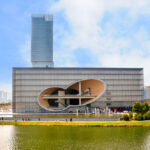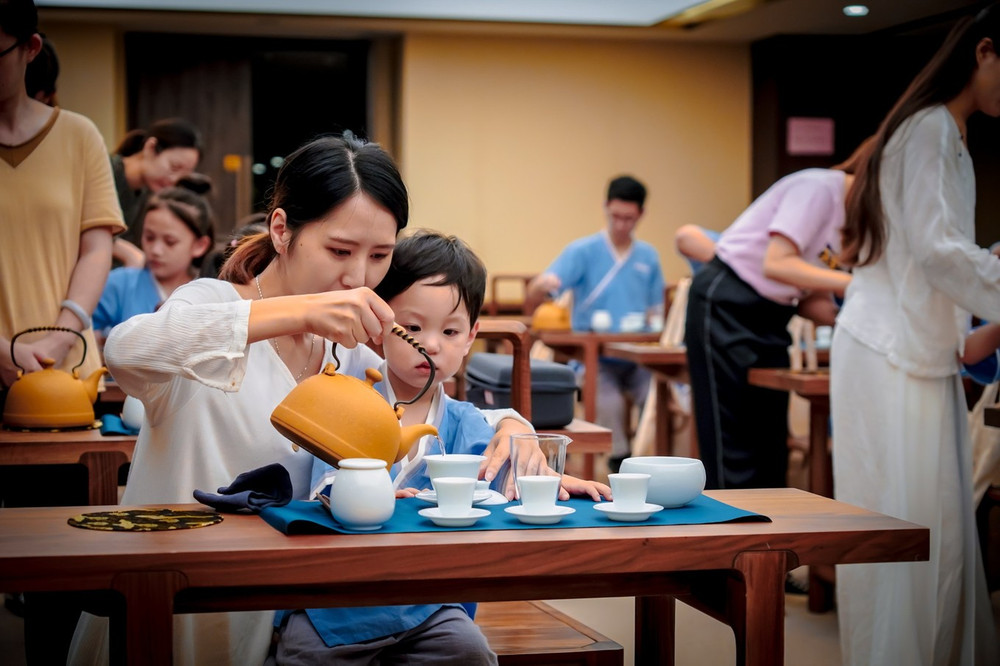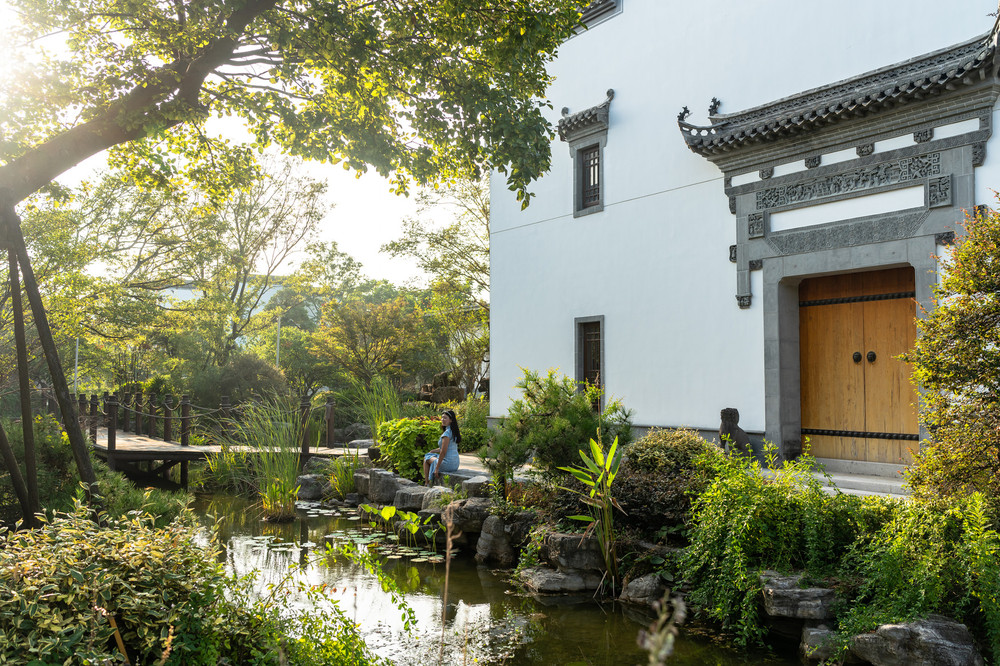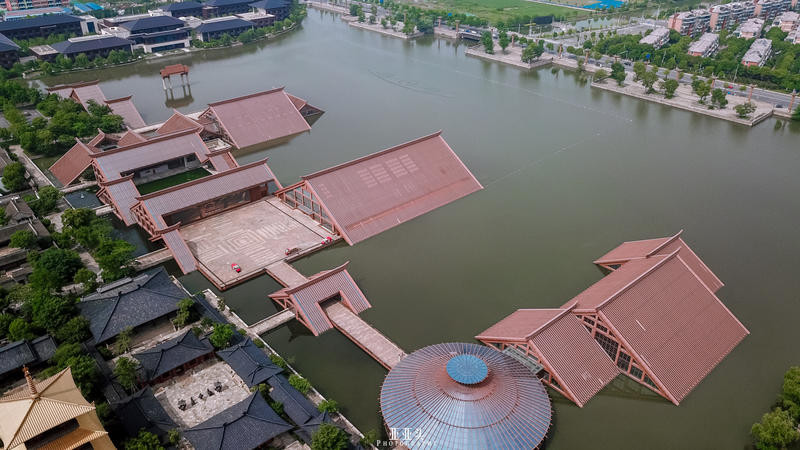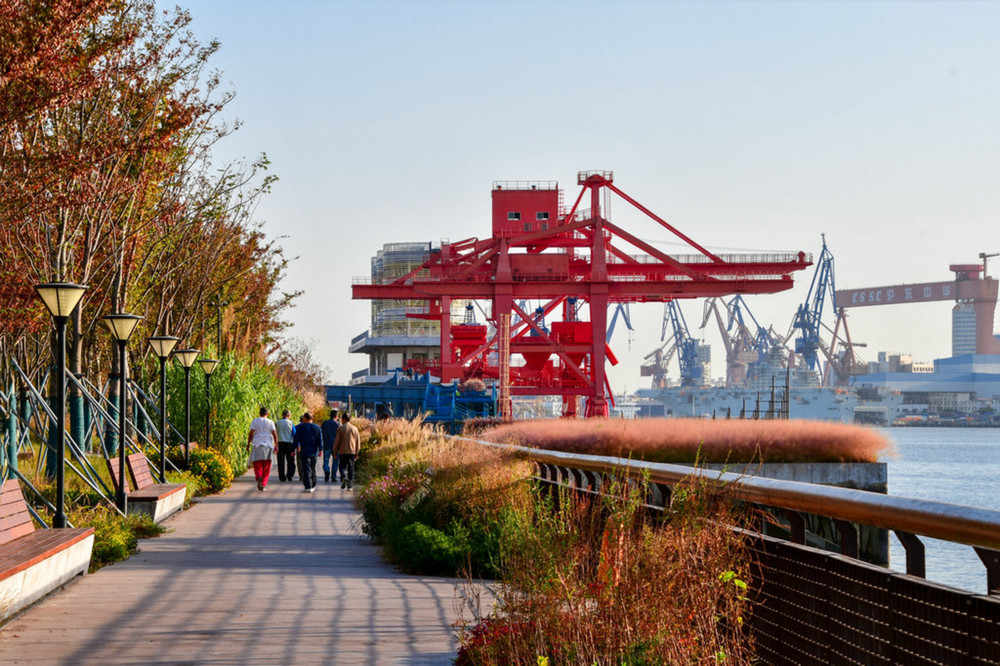On Monday, June 7, 2010, I had planned to take advantage of a working day and the college entrance examination to visit the bustling World Expo. However, it turned out to be more like a World Expo temple fair. The flow of students to the Expo that day reached nearly 40,000, and by 5 pm, the number of people entering the park was 487,900, ranking third among the highest number of visitors since the opening. It was infuriating!

Originally, I wanted to mind my own business, never join the excitement, and eliminate all preconceived ideas, and act according to the situation. In the end, all I could do was hastily wander outside the queues of various shapes and lengths, experiencing the melancholy of the Danish prince: To queue or not to queue? My innate disadvantage of being 5 cm taller than the average height of Chinese people prompted me to give up all queuing activities.
Under the scorching sun (the meteorological station had vowed that it would be cloudy that day), everyone was holding umbrellas. The sharp tips of the umbrellas were waiting for an opportunity to move around my eyes, cheeks, and neck, wanting to put me in a tragic situation of being blind, disfigured, and having my carotid artery punctured. I didn’t want to enjoy the treatment of going through various disabled access channels.
I came up from the South Xizang Road subway station on the Puxi side before 10 am. The large crowd waiting for the opening had already dispersed to every corner of the park (it is said that a large number of people came to occupy a place as early as 4 am). I was able to enter the park after a calm security check. On the left is the Urban Best Practices Area in Zone E, and on the right is the corporate pavilion area in Zone D. My plan was to first go to Zone E and see some successful urban renovation cases (related to my major), and then fight a battle of crossing the river. Go to Pudong and be flexible. Stay until around 9 or 10 pm, and then the trial visit would end.
The Urban Best Practices Area was already crowded. However, fortunately, most people were busy stamping. After stamping, they left immediately. There were very few people like me who lingered. It can’t be entirely blamed on them. In the current environment where form is emphasized more than content, the form of photos and televisions in the Urban Best Practices Area is really not good. Moreover, many national pavilions in Pudong were waiting for people to join the excitement.
I visited the cases of São Paulo, Düsseldorf, Prague, Suzhou, Venice, Pondicherry, Alexandria, Cairo, Bologna, Malmö, Geneva/Zurich/Basel, Bilbao, Barcelona, Makkah Mina, Rhône-Alpes, Alsace, Ningbo Tengtou, and Chengdu. I stopped when I felt sick. Most are not worth seeing. Of course, this can only be known after seeing them.
The Tengtou Pavilion wins in appearance. The wall made of old blue bricks and bamboo slices is relatively special. The Alsace Pavilion has two outer walls of green plants and waterfalls, and a waterfront open-air restaurant. The Chengdu Pavilion is an open living water park and also simulates the Dujiangyan water conservancy project. The Alexandria and Cairo pavilions display some characteristic utensils and small pieces of furniture. Chinese people ignore the requirement of ‘Do not touch’ and trample on the carpet, hit the utensils, and kiss the statues. The foreigners in the pavilion dare not speak out and can only turn a blind eye. The Geneva/Zurich/Basel Pavilion is a huge product placement advertisement promoting a city water treatment company. The existence significance of these pavilions such as Venice, Barcelona, and Bilbao is only for people to get stamps (personal feeling, not of great significance).
The Düsseldorf Pavilion has very detailed content. A declining port has transformed into a livable city full of modern art atmosphere. Naturally, this process is full of difficulties. But looking at the result, no matter how difficult it is, it is worth it. Presumably, the renovation of the Bund now takes the model of the renovation of Düsseldorf’s Rhine Boulevard. However, they are more thorough. They have actually put the entire thoroughfare underground and turned the surface into a city park, connecting the Rhine River and the old city of Düsseldorf.
The Prague Pavilion is very small. The famous Charles Bridge and the sculptures on the bridge in the old city of Prague have been scaled down and moved here. There is also a huge real-life photo by the bridge. The classical and unique style of Central Europe can be well reflected.
The Malmö Pavilion exhibits all the urban water recycling and reuse measures without reservation, although it is only in the form of models and display boards.Pondicherry, my favorite pavilion, was a delightful experience. Beautiful Indian women, dressed up in traditional attire, warmly greeted every visitor. In one corner of the exhibition hall, a collection of old family photos from the colonial period transported us back in time. On the other side of the wall, the 600-year history of Pondicherry unfolded, revealing that it was a French colony until the 1960s. I learned that, despite being located in the southwest corner of India and far from other French colonies, Pondicherry resisted the covetous British and the surging tide of nationalism.
The rest of the exhibition hall showcased the renovation of local ethnic architecture and ancient streets, with bold color usage and before-and-after comparison photos. The Chinese interpreter, dressed in an Indian white robe, introduced the exhibits with great attentiveness. However, the exhibition hall was nearly empty, which seemed unworthy of the Indians’ efforts.
The only time I queued was for a special bus to Pudong. After enduring the scorching sun and parasols for 20 minutes, I barely had time to apply sunscreen before arriving at my destination. The bus stopped near the Qatar Pavilion, where I found more than ten times as many people as in Puxi. The Asian national pavilions in Area A were overcrowded, thanks to the China Pavilion’s辐射效应. Among the over 20 text messages I received, half warned me about the queuing times for popular pavilions and advised against wasting my efforts.
The Expo Axis and elevated walkway were scenes of rest and queuing, reminiscent of the grand occasion of people worshipping the Saudi Arabia Pavilion and making a pilgrimage to Mecca. The smell and crowding degree were comparable to a railway station during the Spring Festival travel rush. I hurriedly fled this precious land, climbing up the elevated walkway, trying to forget the adults and children defecating and urinating everywhere below, men and women lying around, people eating and chatting and laughing, and those who were disrespectful to the elderly and spray food on others’ faces when they were so engrossed in conversation.
The elevated walkway was clean and decent, a stark contrast to the dirt and filth below. This was like today’s society: a brocade robe on the outside, and inside, a multitude of various phenomena. But when there are too many maggots, they will always crawl out. The extent of the crowd was evident in the queues at the dining area entrance, the Swiss Pavilion’s store, and the long line at the toilet, with many restless and twitchy-faced people.
The Ireland Pavilion, with its glass outer wall, also had a long queue, reminiscent of kindergarten children visiting, just short of holding onto each other’s back hems.
Duration: 1 day. The author visited these places: The Bund, Lupu Bridge. Published on June 11, 2010, at 15:41. On Monday, June 7, 2010, I intended to take advantage of the workday and the high school examination period to immerse myself in the bustling World Expo. However, I ended up joining a temple fair at the Expo, and while waiting in line outside the pavilion in the evening, I received a callous update: to make way for the high school exams, the city government had given a holiday to students from other grades, leading to a near 40,000 student influx at the Expo that day. By 5 PM, the number of visitors had reached 487,900, making it the third highest attendance since the park opened. Frustrating! I had planned to keep to myself, avoid the crowds, and refrain from any preconceived notions, acting only when the opportunity presented itself. In the end, all I could do was to anxiously hover outside the various lines of different shapes and lengths, experiencing a Prince of Denmark-like melancholy: To queue, or not to queue? It was my height, which exceeds the national average by 5 cm, that ultimately led me to abandon all queuing activities. Under the scorching sun (the weather bureau had confidently predicted overcast skies), everyone was holding umbrellas, with sharp tips poised to poke my eyes, cheeks, and neck, putting me in a pitiable situation of being blinded, disfigured, or having my carotid artery punctured. I did not wish to enjoy the treatment of various disabled passages.I arrived at the Pudong Tibet South Road subway station before 10 AM. The large crowd waiting for the park to open had already dispersed to various corners within the park. (It is said that a large group of people arrived at 4 AM to secure a spot.) I was able to calmly pass through security and enter the park. The Urban Best Practices Area (E zone) was on my left and the Enterprise Pavilion Area (D zone) was on my right.
My plan was to start with the E zone to see some successful urban renovation cases (related to my profession). Then, wage a river-crossing campaign to the flexible and mobile Pudong. I planned to linger until the evening around nine or ten o’clock, marking the end of my trial journey.
The case pavilions were already bustling with people. But fortunately, most were busy stamping and leaving quickly. There were few people like me who lingered. It’s not entirely their fault. Given the current environment that values form over content, the photo and TV format of the case pavilions is not very appealing. Let alone the many national pavilions in Pudong waiting for people to join the excitement.
I visited the cases of São Paulo, Düsseldorf, Prague, Suzhou, Venice, Alexandria, Cairo, Bologna, Malmö, Geneva/Zurich/Basel, Bilbao, Barcelona, Mecca Mina, Rhône-Alpes, Alsace, Ningbo Tengtou, and Chengdu. Until I felt nauseous and decided to stop. Most were not worth the visit. Of course, this is only known after seeing them.
The Tengtou Pavilion stood out for its exterior. Old blue bricks and bamboo slats formed a unique wall. The Alsace Pavilion featured green plants and waterfalls on both exterior walls. Along with a waterside open-air restaurant. The Chengdu Pavilion was an open living water park that also simulated the Dujiangyan water conservancy project. The Alexandria and Cairo Pavilions displayed some characteristic artifacts and small furniture pieces. Chinese visitors ignored the ‘do not touch’ signs, trampling on carpets, slapping artifacts, and kissing statues. While the foreigners in the pavilion dared not speak out and could only turn a blind eye. The Geneva/Zurich/Basel Pavilion was a huge embedded advertisement promoting a city water treatment company. The Venice, Barcelona, and Bilbao Pavilions seemed to exist solely for people to stamp their passports. (My personal feeling, not of great importance.)
The Dusseldorf Pavilion offers a comprehensive display. It showcases how a once-declining port has transformed into a modern, art-filled, and livable city. The challenges faced during this transformation are evident. But the end result justifies the hardships. The Bund’s renovation seems to take its cue from the model of Dusseldorf’s Rhine promenade. But it goes a step further by burying the entire thoroughfare underground. Creating an urban park above and unifying the Rhine River with the old town of Dusseldorf. In contrast, the Bund has only partially buried its traffic flow underground.
The Prague Pavilion, though small, brings a scaled-down version of the famous Charles Bridge and its sculptures from the old city of Prague. Accompanied by large-scale real-life photographs. Effectively capturing the classical charm of Central Europe.
The Malmo Pavilion exhibits the city’s water recycling and reuse initiatives in a model and panel format. Leaving no stone unturned.
My favorite pavilion is the Pondicherry one. Beautiful Indian women in traditional attire warmly greet each visitor. One corner of the pavilion is filled with old family photos from the colonial era. Another wall tells the 600-year history of Pondicherry. It was only after watching the introduction that I learned Pondicherry was a French colony until the 1960s. Located in the southwest corner of India, far from other French colonies. How did it manage to withstand the covetous British and the surging tide of nationalism until the 1960s? The rest of the pavilion is dedicated to the restoration of local ethnic architecture and ancient streets. With before-and-after photos showing bold use of color. The Chinese-speaking guides, dressed in Indian white robes, provide very attentive introductions. However, the number of visitors in the pavilion does not match the dedication of the Indians.
The only queue I stood in was for the dedicated bus to Pudong. Enduring the dual assault of the scorching sun and sun umbrellas for 20 minutes. Once on the bus, I hadn’t even finished applying sunscreen before arriving. The bus stops near the Qatar Pavilion. Upon looking around, the number of people is more than ten times that of Puxi. Thanks to the radiating effect of the China Pavilion, all the Asian country pavilions in Area A are packed with visitors. Not to mention the astonishingly luxurious Saudi Pavilion. Half of the more than 20 text messages I received onI hastily left this treasured place, climbed onto the elevated walkway, and tried to forget the adults and children defecating indiscriminately below, the men and women lying exposed, the elderly who, in the midst of eating and laughing, sprayed food on others, and the already reported strange tales of pretending to be disabled and groups of primary school students entering in child carts.
The elevated walkways are clean and decent, with no view of the filth hidden below, much like today’s society, which presents a splendid exterior while harboring a myriad of complexities beneath; yet, when the maggots multiply, they will inevitably crawl out.
The sheer number of people is staggering. Lines form at the entrance of the dining areas as people wait to get in; shopping at the Swiss Pavilion’s store requires queuing, with a strict one-in-one-out policy; restroom lines are long, filled with those who can barely contain their discomfort, their faces contorted with urgency. The Irish Pavilion’s exterior is made of glass, and inside, the queues continue, reminiscent of a kindergarten field trip, save for the lack of children holding onto each other’s collars. The multitudes of human-shaped decorations outside each pavilion need not even be mentioned.
In the initial days, the World Expo organizers reported an average of 400,000 visitors, with peak numbers potentially reaching 800,000, a spectacle beyond my imagination. In the afternoon, I wandered aimlessly, targeting any pavilion without a queue at the entrance, with the only victories being the Oceania Pavilion, the Africa Pavilion, and Ukraine. In the combined pavilions, it suffices to visit just 2-3 booths, as they all share a similar theme: a few photos, some handicrafts, and a few totem sculptures in indigenous styles. There are also one or two countries that send attractive, mixed-race men and women dressed in traditional attire to take亲密合影s with visitors, eliciting bursts of excited screams. The Ukraine Pavilion was a complete letdown due to television’s false advertising; the promised embroidery and craft demonstrations were nowhere to be found. Inside, it was a dimly lit large bar, a sales counter, a stamping desk, and the remaining space was no larger than a typical three-bedroom home. My eyes hadn’t even adjusted from the bright light outside to the dimness within when I was already—out again.
At dusk, I visited the Houzhai Park at the foot of the Lupu Bridge, originally a wetland by the Huangpu River, slightly modified to retain its wild charm. Across the street is the basket-shaped Spanish Pavilion, surrounded by human-shaped ants swarming from all directions, perhaps indicating that there is indeed something inside that ants would find appealing. Houzhai Park could almost be considered a pristine sanctuary within the Expo grounds, surprisingly sparsely populated. I am generally critical, but if not for the indecent couples and the girls who ruthlessly destroy flowers, this place would be an ideal kingdom.
Finally, as night fell (after spending an hour at the True Pot, enduring subpar service and food that did not match the True Pot’s reputation), it seemed that there were fewer people. I queued for 20 minutes to enter the Turkey Pavilion. The Turkey Pavilion features a museum on the first floor and a cinema on the second. The museum introduces 6,000 years of Turkish history, complete with replica sculptures and ancient city ruins. In the center of the exhibition hall, a gorgeous traditional robe and a giant sculpture are both protected by wire mesh to prevent damage from the visitors. On one side wall, dozens of television screens are installed, each screening a film. The content covers the ancient city ruins dating back to 4200 BC and the computer-simulated original appearance of the city, cultural relics, the city’s water diversion channel that has been passed down to this day, and the history of cultural exchanges between China and foreign countries. People in a hurry stop in front of each exhibition showcase for two seconds, take a photo and leave to complete their journey of getting stamps. I don’t know how many people will truly be impressed by this Expo carnival. On the second floor is a 360-degree panoramic movie theater showing street scenes of Istanbul. People feel as if they are on the scene. However, there is an obnoxious Turkish staff member who is constantly urging the crowd to move quickly. Everyone is really cooperative. They come up from the left and quickly go downstairs on the right. The people waiting for stamps almost knock over the counter. The Turks nearby exchange ambiguous expressions with each other. We can’t blame others for looking down on us. We despise ourselves first.
I also visited the pavilions of Angola, Tunisia, Algeria, and Nigeria. The reasons for still visiting these non-mainstream pavilions are as follows. First, the pavilions that had long queues during the day are stillNow that they appear in a concentrated way, it is a rare opportunity. For countries like Britain, France, Germany, the United States, and Japan, we are all eager to understand them, but they are still playing hard to get. However, what is the chance that we know about the Berbers in North Africa? The things in middle school history and geography textbooks are vividly displayed in front of us, and it only costs more than one hundred yuan. Moreover, there is no exam. Finally, it is also because I am extremely good at consoling myself. Today is only the first time. There will be plenty of opportunities. If it really doesn’t work, there is still a tactic of self-inflicted pain. At worst, I can intentionally break a leg bone. Then I can go through the green channel with a cast. The Israel Pavilion, New Zealand Pavilion, British Pavilion (the above are due to professional reasons), Russian Pavilion, and Egyptian Pavilion that I am longing for. I hope they won’t disappoint my soon-to-be-broken leg bone.

